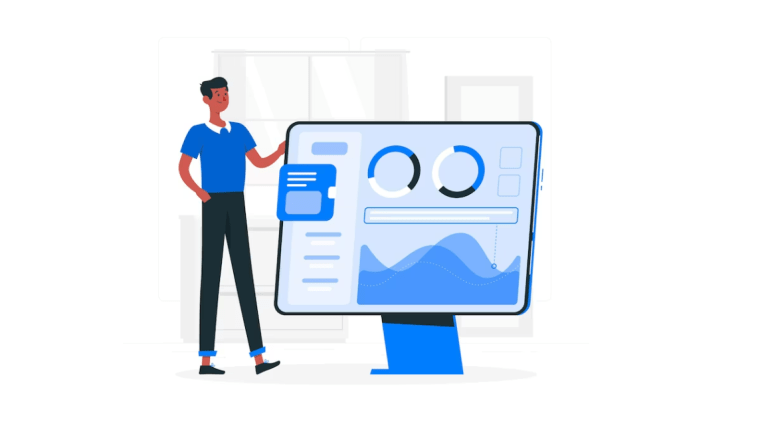Importance of data visualization in decision-making
In today’s data-driven world, dashboards and reports have become essential tools for businesses of all sizes and industries. Dashboards are visual representations of data that allow for quick insights and analysis, while reports are detailed and comprehensive documents that provide context and background information. Both tools are used to make sense of complex data and help decision-makers make informed choices that drive business success.
Data visualization is a crucial part of decision-making, as it allows for the clear and concise presentation of complex data. By using charts, graphs, and other visual aids, decision-makers can quickly identify trends and patterns in the data, making it easier to develop strategies and make informed choices.
The purpose of this article is to compare dashboards and reports and determine which is better for different types of data and decision-making. We will explore the differences between these two tools, their advantages and disadvantages, and the scenarios in which they are best utilized. By understanding the differences between dashboards and reports, businesses can choose the right tool to meet their specific needs and improve their decision-making processes.
What are dashboards?
A dashboard is a visual representation of data that allows users to monitor and analyze key performance indicators (KPIs) and metrics in real-time. It is a tool that is designed to be interactive and customizable, allowing users to drill down into the data to identify trends and patterns. The key features of dashboards include real-time data updates, interactivity, customization, and visual appeal. You can create amazing dashboards using Dashboard PowerPoint Templates – Slidebazaar
One of the most significant advantages of dashboards is that they provide real-time data updates. This means that decision-makers can monitor key metrics and KPIs in real-time, allowing them to make informed decisions quickly. The interactivity of dashboards allows users to explore the data in greater detail and gain deeper insights. Customization options also make dashboards more flexible, allowing users to tailor the data to their specific needs and objectives. Dashboards allow for quick insights and analysis, helping decision-makers identify potential issues before they become significant problems.
Dashboards are visually appealing and easy to understand. By using charts, graphs, and other visual aids, decision-makers can quickly and easily understand the data, making it easier to develop strategies and make informed choices. Dashboards are used in various industries, such as sales, marketing, and finance. For example, a sales dashboard is a visual representation of key sales metrics and KPIs, such as revenue, sales volume, and customer acquisition costs. It allows sales teams to monitor their performance in real-time, identify trends and patterns, and adjust their strategies accordingly. A marketing dashboard is a visual representation of key marketing metrics and KPIs, such as website traffic, social media engagement, and email open rates. It allows marketers to monitor their performance and adjust their strategies accordingly. A financial dashboard is a visual representation of key financial metrics and KPIs, such as revenue, expenses, and profit margins. It allows finance teams to monitor their performance in real-time, identify trends and patterns, and adjust their strategies accordingly.
What are reports?
Reports are a way of presenting data in a structured and organized manner, usually in a written format. There are various types of reports, such as analytical reports, informational reports, and research reports, among others. Reports are typically more detailed and comprehensive than dashboards, providing context and background information to the reader.
One of the advantages of reports is that they offer a more detailed and comprehensive view of the data, making them suitable for presenting complex information. Reports can also provide context and background information, helping readers understand the data in a broader context. Reports often have a standardized format, making them easy to share and distribute among stakeholders.
Reports are used in various industries, such as sales, marketing, and finance. A sales report typically includes detailed information on sales revenue, sales volume, and customer acquisition costs. It can also include information on customer demographics and buying behavior. A marketing report provides details on marketing campaigns, website traffic, social media engagement, and email open rates. It can also include insights on customer behavior and preferences. A financial report provides detailed information on financial performance, such as revenue, expenses, and profit margins. It can also include details on investments, cash flow, and financial ratios.
In summary, while dashboards are more focused on providing real-time data updates and interactive visualization, reports offer a more comprehensive view of data, with detailed information and context. Reports are useful for sharing insights and making data-driven decisions, while dashboards are suitable for monitoring performance and identifying trends.
Comparison of Dashboards and Reports
Dashboards and reports are both data visualization tools, but they serve different purposes and have different design approaches.
The main difference between dashboards and reports is their purpose and usage. Dashboards are designed for real-time monitoring of key metrics and KPIs, while reports are typically more comprehensive, providing in-depth analysis and context. Dashboards are more interactive, allowing users to drill down into the data and identify trends and patterns, while reports are more static and provide a standardized view of the data.
Dashboards are designed to be visually appealing and user-friendly, with a focus on data visualization. Reports, on the other hand, prioritize information accuracy, completeness, and contextualization. Dashboards are more suitable for quick decision-making and monitoring performance, while reports are more appropriate for in-depth analysis and insights.
The advantages of dashboards include real-time data updates, interactivity, customization, and visual appeal. The disadvantages of dashboards are that they can be oversimplified and lack context, making it challenging to understand complex data. The advantages of reports include their comprehensive nature, context, and standardization. However, reports can be time-consuming to create and may not provide real-time data updates.
In conclusion, both dashboards and reports have their advantages and disadvantages, and the choice between the two depends on the type of data and decision-making needed. Dashboards are suitable for real-time monitoring and quick insights, while reports are more appropriate for in-depth analysis and context. A combination of both tools may be the best solution for decision-makers, allowing for real-time monitoring and comprehensive analysis of data.
Conclusion
Both dashboards and reports are essential tools for data analysis and decision-making. Dashboards are suitable for real-time monitoring and quick insights, while reports are more appropriate for in-depth analysis and context. When choosing between dashboards and reports, it is essential to consider the type of data and decision-making needed. A combination of both tools may be the best solution for decision-makers, allowing for real-time monitoring and comprehensive analysis of data. The key is to choose the right tool for the right job, and both dashboards and reports have their strengths and weaknesses. Ultimately, the choice between the two depends on the specific needs and goals of the organization or individual.




